Taking Groundwork to the Next Level
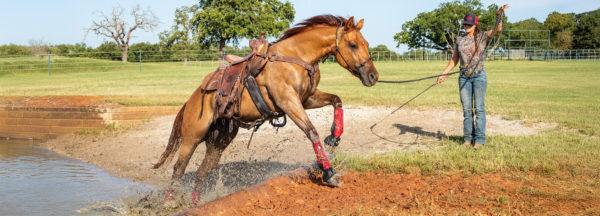
During the third week of the six-week Fundamentals training program, horses are introduced to the obstacle course. At this point in their training, the horses have been taught all of the Fundamentals level groundwork exercises and are ready to take their groundwork training to the next level. The obstacle course challenges the horses and exposes any holes they have in their training.
Like with anything you do with a horse, when you start working on obstacles, you begin with the easiest obstacles first and then progress to more challenging obstacles. This way, you build the horse’s confidence and set him up for success.
When Clinton began having the Academy class work on the obstacle course, they’d all meet together and focus on an obstacle or two as a group. Then everyone would spread out around the course and work on obstacles of their choosing. From that point on, working on the obstacle course replaced focusing on groundwork exercises in the arena.
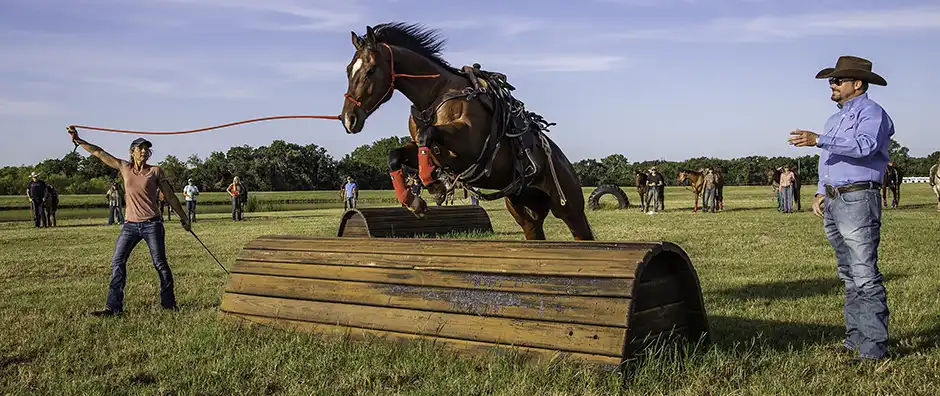
Getting a Horse Confident
One of the group lessons focused on getting a horse confident about jumping over rolltops. Clinton had Tracy work with her horse while he coached her through the training session. The key to getting a horse to jump an obstacle is to ensure he has enough forward energy and momentum in his feet to get over it.
“A common mistake people make is to apply pressure to the horse when he’s close to the jump. At that point, it’s too late to get forward energy for the jump, and it often has the complete opposite effect than what the person wants to have happen. Instead of the horse speeding up his feet, it makes him back off. The more you try to force a horse to do something, the more he doesn’t want to do it,” Clinton said.
“If you need to get energy in his feet, you spank the ground—or him, if necessary—when he’s away from the jump. Then you let that momentum carry him over it. Many times, when you see a horse refusing to jump an obstacle, it’s not because the horse is scared or being belligerent, it’s because he’s not being set up properly.”
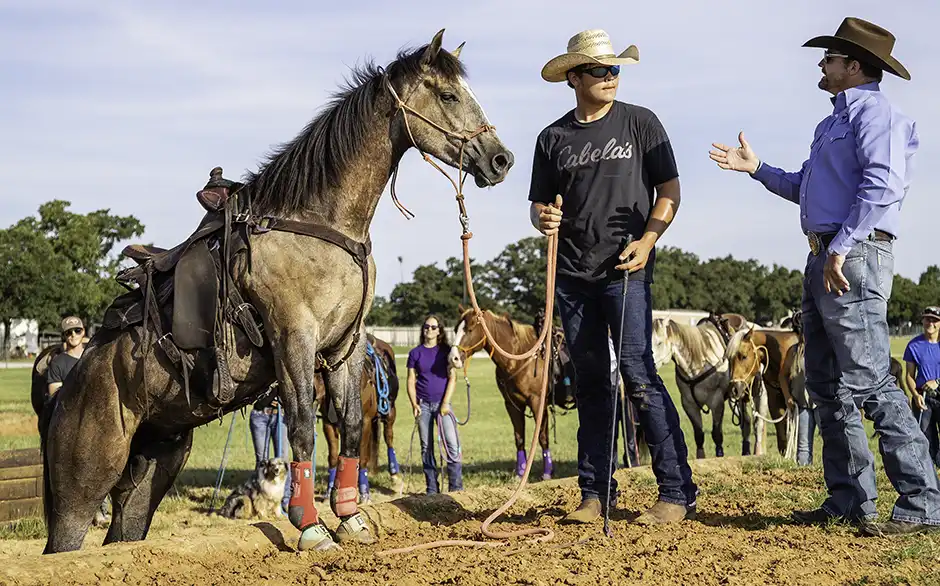
Be Realistic About Your Expectations
While Jeffery’s gray horse possessed a lot of good qualities, being nimble and light on his feet on the obstacle course wasn’t one of them. After the horse had made a couple of messy attempts at jumping up the sunken road, Clinton took the opportunity to talk to the class about each horse’s ability and being realistic about your expectations.
“Horses are just like people: Some of us are naturally athletic and some of us aren’t. You have to learn to recognize your horse’s ability and adjust your expectations accordingly. One horse’s A+ might be another horse’s C-,” Clinton explained. “As long as the horse is giving you his best effort, be happy with it.”
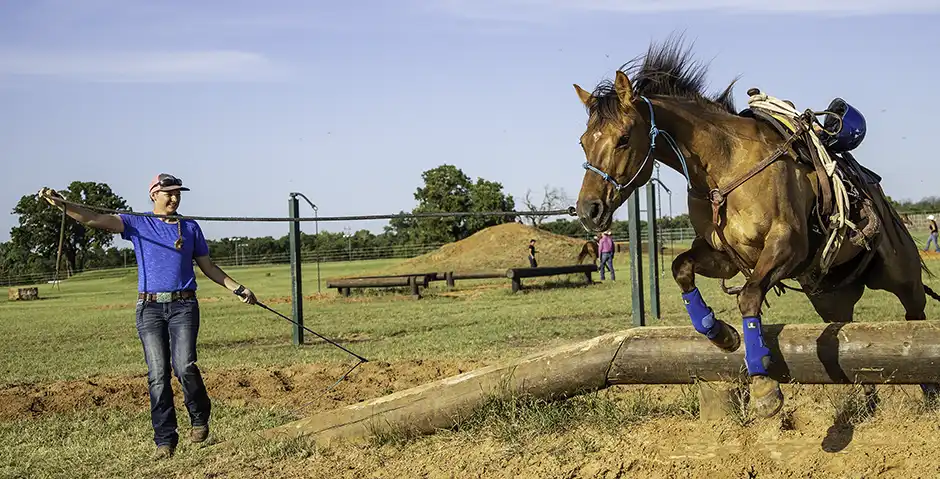
One Step at a Time
A simple jump, like the single log on the obstacle course that Joni is asking her mare to go over, is an ideal obstacle to begin with when teaching a horse to jump. It’s straightforward and encourages the horse’s confidence.
“One of the quickest ways to wreck a horse’s confidence is to put him on an obstacle he doesn’t have the ability to handle. When you learned to swim, your parents didn’t throw you out in the middle of a lake. They took you to the shallow end of the baby pool,” Clinton said.
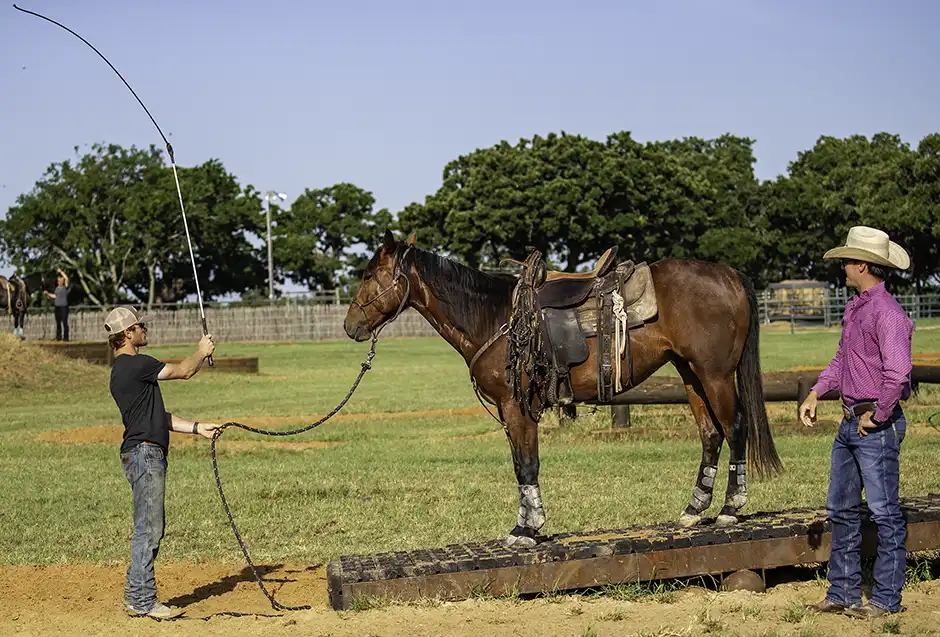
Teach Your Horse to Use the Thinking Side of His Brain
Method Ambassador Josh Standen worked with Wyatt on the teeter-totter bridge. After getting his horse confident about stepping on and off the bridge, Wyatt stopped the horse on top of the bridge and let him rest there while he desensitized him to the stick and string.
“The teeter-totter bridge is a great obstacle to incorporate into your training program to teach your horse to use the thinking side of his brain. Horses hate objects that move and make a noise, which the bridge does both of,” Clinton said. “They are also useful in preparing a horse for loading onto trailers because the sound the bridge makes as the horse steps up onto it and the way it moves under his weight resemble walking up the trailer ramp and onto the trailer itself.”
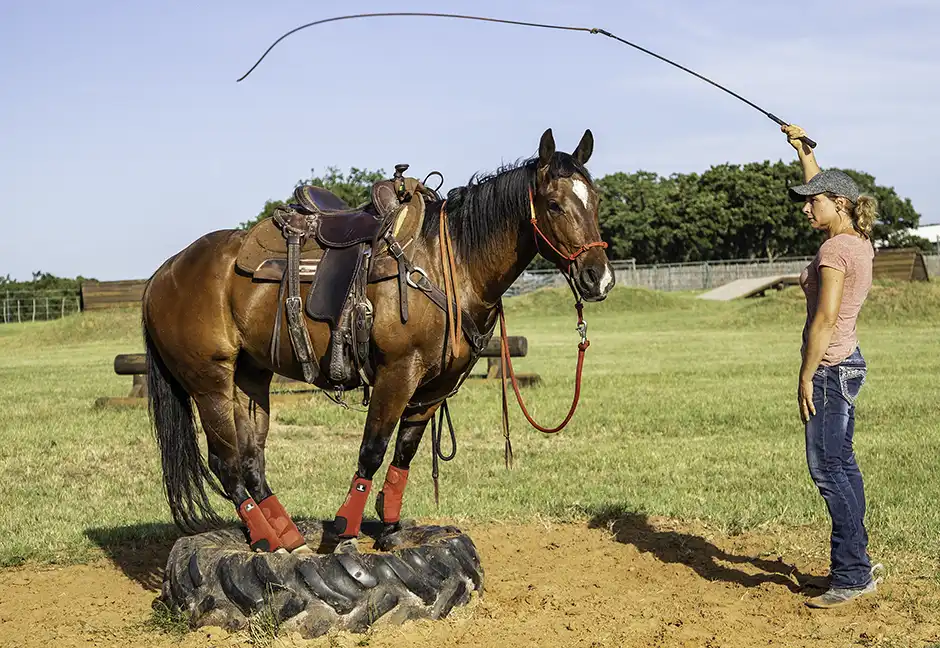
Get Horse to Crave Obstacles
After teaching the horses how to negotiate the obstacles, students focused on getting the horses to crave being on or near the obstacles. The key to doing that is to work the horse’s feet away from the obstacle and let him rest on it or as close to it as possible.
“It’s the same concept we use when teaching a horse to crave being on the trailer. We hustle his feet outside the trailer and get him huffing and puffing a little, and then we offer him the opportunity to rest and relax on the trailer. Before long, the horse practically runs onto the trailer by himself,” Clinton said.
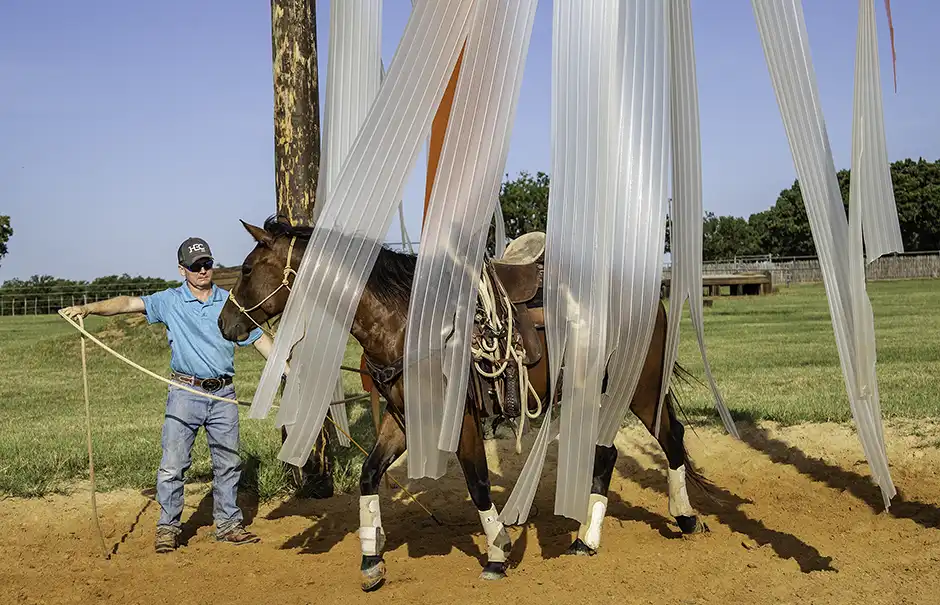
The Cowboy Curtain
Because it moves and makes a noise, the Cowboy Curtain is one of the more advanced obstacles on the course and isn’t introduced to the horses until later in the training program. Larry works on building his horse’s confidence about pushing through the curtains.
“Asking a horse to walk through an object that he can’t see through and one that hangs above his eye level and moves and makes a noise as he passes through it, requires an immense amount of trust in you as his leader,” Clinton said. “To help make the obstacle less overwhelming for your horse initially, I recommend using a bungee cord to fasten a good chunk of the curtain strips to one of the poles. You want to give the horse about a 4-foot space to pass through. This will create an open gap for your horse to walk through and will make the obstacle seem a little less intimidating to him because there’s an opening he can see and it allows him to see through the obstacle to the other side. As he gains confidence about the obstacle, you’ll let the strips down, one by one.”
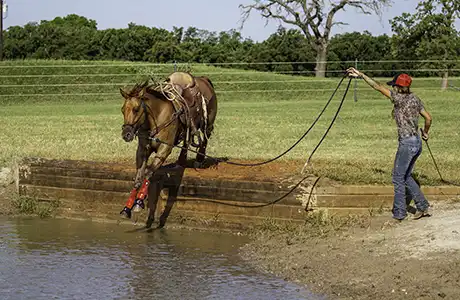
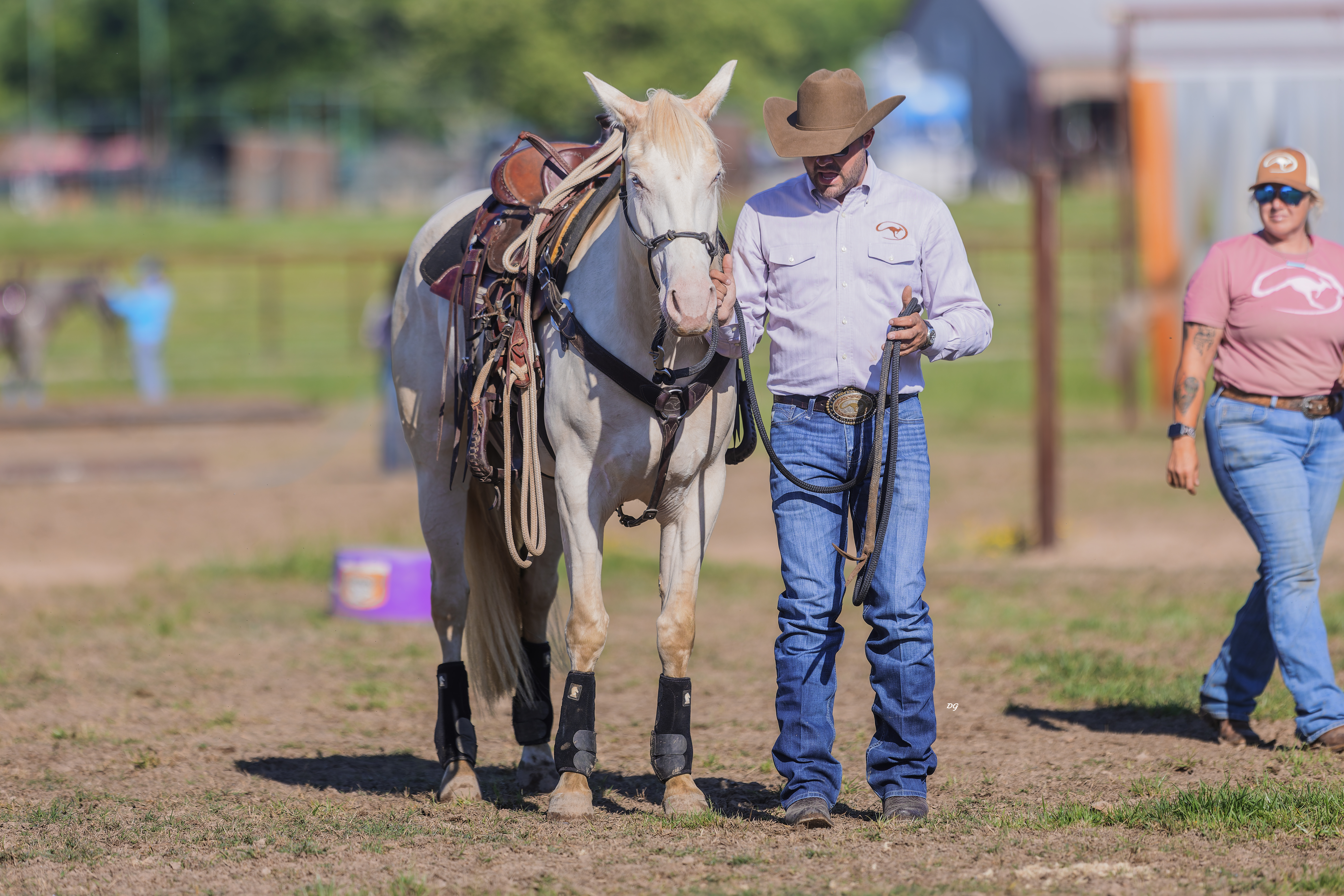
A Challenging Obstacle
Rachel worked on sending her horse down into the small pond and out of it. Water is a challenging obstacle to begin with, and when you start asking a horse to jump into it, you increase the challenge. Because horses have poor depth perception, it can be hard for them to tell how far away an object is from them or how deep it is. “Because your horse has no idea of the water’s depth, for all he knows you’re asking him to jump into a black hole,” Clinton said.
“Asking the horse to jump into water makes the obstacle scarier because you’re approaching it at a faster gait, and when he lands in the water, it splashes more and makes more noise. It’ll test your ability to keep momentum in the horse’s feet,” he added.

Every obstacle course session ended with the students taking their horses into the big pond. Christa used the Approach and Retreat Method to get her horse to step into the water.
Where to Begin
When horses are first introduced to the obstacle course, these are the obstacles students begin with because they are relatively easy and build the horse’s confidence.
- Log Circle
- Row of Logs
- Sunken Road
- Staircase (except third tier)
- Bull’s-Eye
- Mini Sunken Road
- Long Gulley
- Single Log
- Small Rolltops
- Mountain
- Small Pond
- Big Pond
